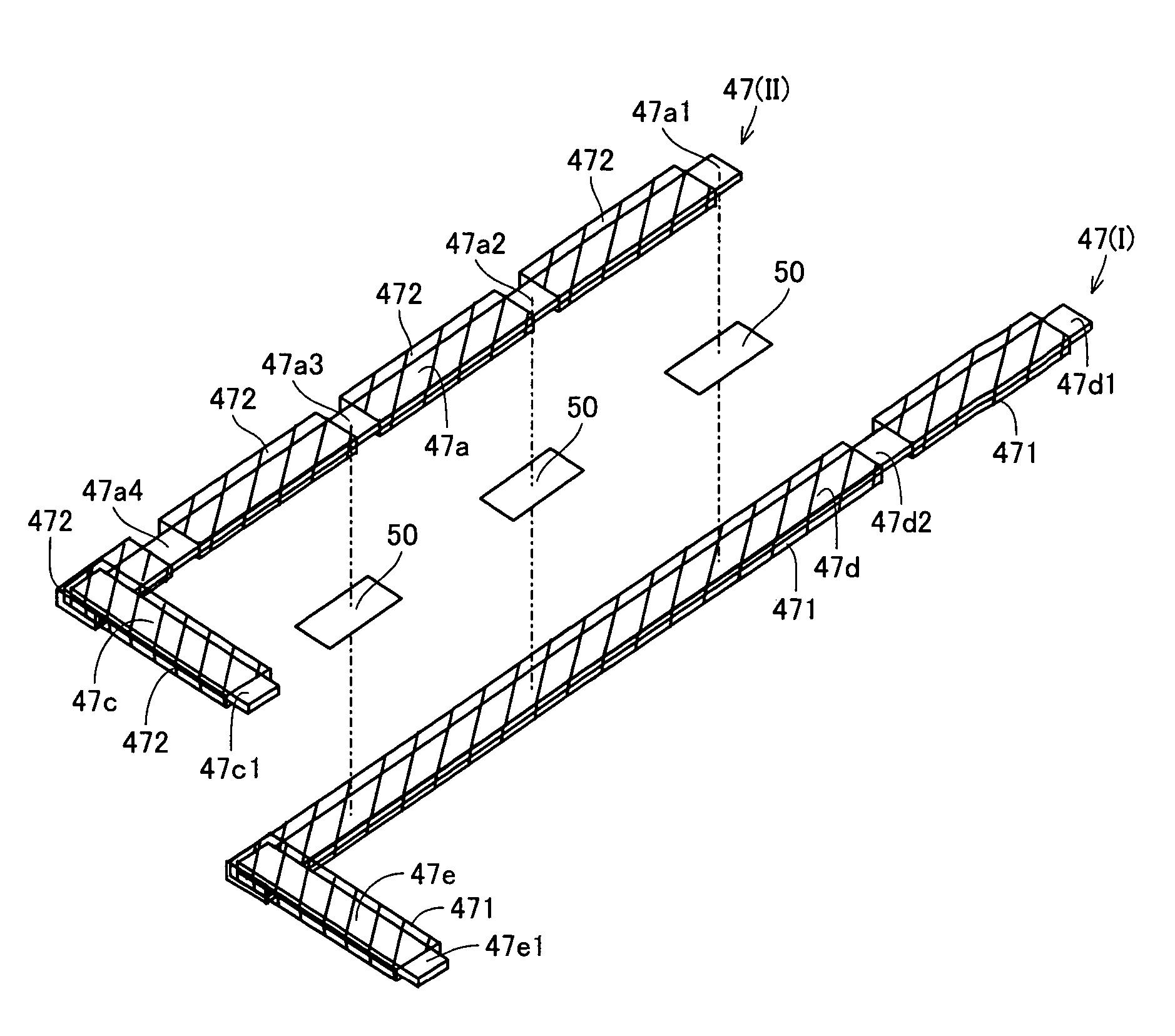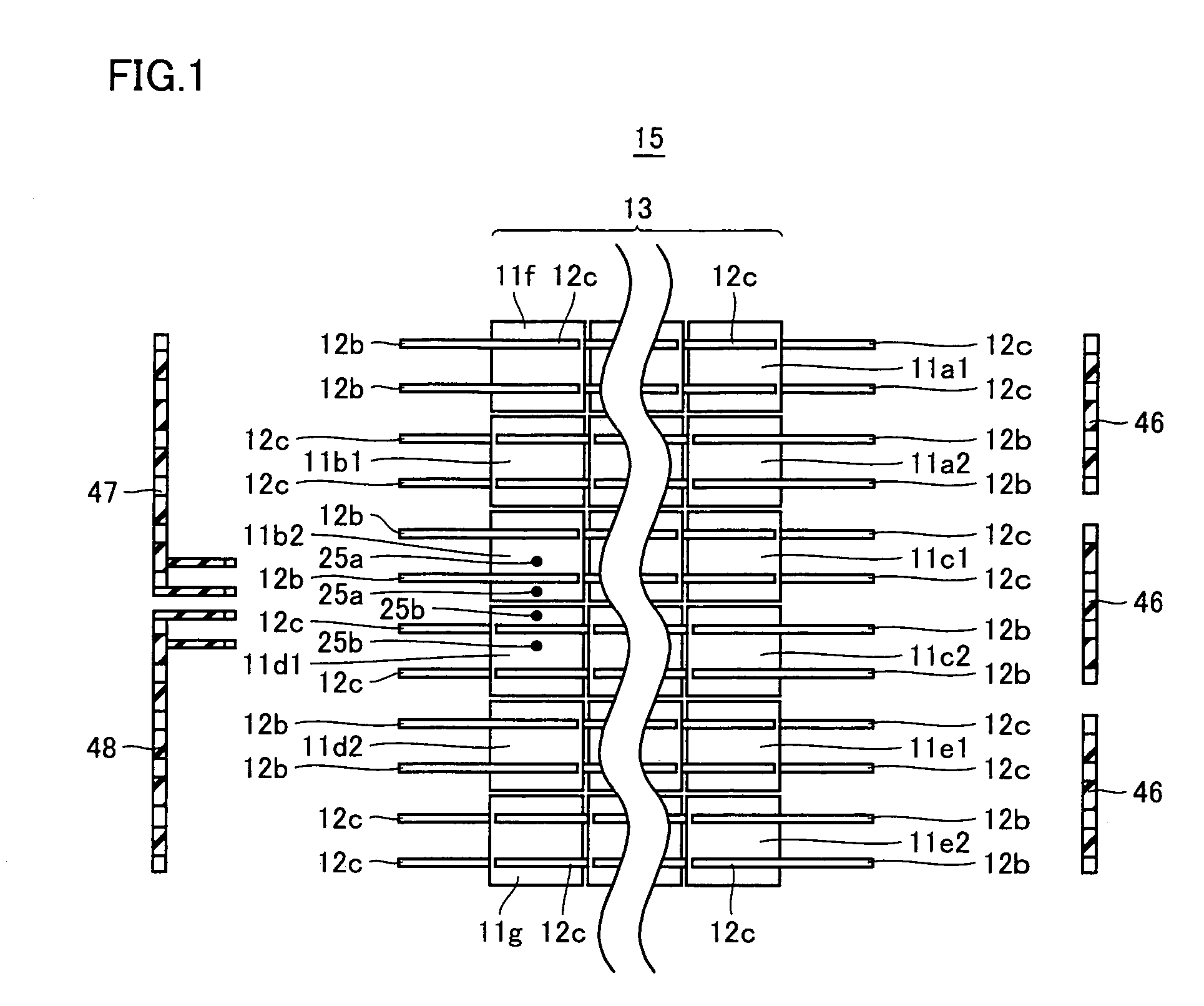Integrated wiring member for solar cell module, solar cell module using the same, and manufacturing methods thereof
a solar cell module and solar cell technology, applied in the direction of manufacturing tools, pv power plants, coatings, etc., can solve the problems of solder-plated wiring materials, insulation failure, and variation in outer appearance, so as to suppress insulation performance failure, reduce external variation, and improve aesthetics
- Summary
- Abstract
- Description
- Claims
- Application Information
AI Technical Summary
Benefits of technology
Problems solved by technology
Method used
Image
Examples
embodiment 1
(Solar Cell Module)
[0138]With reference to FIG. 1, a solar cell module according to the present invention has the following structure. That is, a plurality of solar cells 11 are arranged in line and are electrically connected to each other to thereby form a cell unit 13. Then, a plurality of cell units 13 formed as described above are arranged side by side, and the adjoining solar cells (e.g., 11a1 and 11a2, 11b1 and 11b2, and the like) located at respective both ends of cell units 13 are electrically connected to each other through integrated wiring members 46, 47 and 48; thus, the solar cells arranged in a form of a matrix 15 are entirely connected to each other in series. In the present invention, each of wiring members 46, 47 and 48 for electrically connecting between the solar cells is of an integrated type, unlike a conventional wiring member.
[0139]In an integrated wiring member according to the present invention, a portion other than a connection portion, in which solar cells...
embodiment 2
[0212]In Embodiment 2, description will be given of another embodiment of the integrated wiring member according to the present invention. FIG. 10 is a perspective view illustrating first wiring member 47(I) and second wiring member 47(II) separated from each other in first integrated wiring member 47. FIG. 11 is a perspective view illustrating first integrated wiring member 47 in which first wiring member 47(I) and second wiring member 47(II) separated from each other in FIG. 10 are integrated with each other. FIG. 12 is a perspective view illustrating first wiring member 48(I) and second wiring member 48(II) separated from each other in second integrated wiring member 48. FIG. 13 is a perspective view illustrating second integrated wiring member 48 in which first wiring member 48(I) and second wiring member 48(II) separated from each other in FIG. 12 are integrated with each other.
[0213]As illustrated in FIGS. 10 and 12, Embodiment 2 is similar to Embodiment 1 except that there ar...
embodiment 3
[0219]In Embodiment 3, description will be given of still another embodiment of the integrated wiring member according to the present invention. FIG. 15 is a perspective view illustrating first wiring member 47(I) and second wiring member 47(II) separated from each other in first integrated wiring member 47. In FIG. 15, second wiring member 47(II) is coated with no coating member. FIG. 16 is a perspective view illustrating first integrated wiring member 47 in which first wiring member 47(I) and second wiring member 47(II) separated from each other in FIG. 15 are integrated with each other. FIG. 17 is a perspective view illustrating a state where the first integrated wiring member in FIG. 16 is coated with the coating member.
[0220]FIG. 18 is a perspective view illustrating first wiring member 48(I) and second wiring member 48(II) separated from each other in second integrated wiring member 48. In FIG. 18, second wiring member 48(II) is coated with no coating member. FIG. 19 is a pers...
PUM
| Property | Measurement | Unit |
|---|---|---|
| thickness | aaaaa | aaaaa |
| width | aaaaa | aaaaa |
| width | aaaaa | aaaaa |
Abstract
Description
Claims
Application Information
 Login to View More
Login to View More - R&D
- Intellectual Property
- Life Sciences
- Materials
- Tech Scout
- Unparalleled Data Quality
- Higher Quality Content
- 60% Fewer Hallucinations
Browse by: Latest US Patents, China's latest patents, Technical Efficacy Thesaurus, Application Domain, Technology Topic, Popular Technical Reports.
© 2025 PatSnap. All rights reserved.Legal|Privacy policy|Modern Slavery Act Transparency Statement|Sitemap|About US| Contact US: help@patsnap.com



